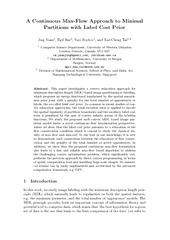A Continuous Max-Flow Approach to Minimal Partitions with Label Cost Prior
Chapter, Peer reviewed
Accepted version
Permanent lenke
https://hdl.handle.net/1956/5023Utgivelsesdato
2011Metadata
Vis full innførselSamlinger
Sammendrag
This paper investigates a convex relaxation approach for minimum description length (MDL) based image partitioning or labeling, which proposes an energy functional regularized by the spatial smoothness prior joint with a penalty for the total number of appearences or labels, the so-called label cost prior. As common in recent studies of convex relaxation approaches, the total-variation term is applied to encode the spatial regularity of partition boundaries and the auxiliary label cost term is penalized by the sum of convex infinity norms of the labeling functions. We study the proposed such convex MDL based image partition model under a novel continuous flow maximization perspective, where we show that the label cost prior amounts to a relaxation of the flow conservation condition which is crucial to study the classical duality of max-flow and min-cut! To the best of our knowledge, it is new to demonstrate such connections between the relaxation of flow conservation and the penalty of the total number of active appearences. In addition, we show that the proposed continuous max-flow formulation also leads to a fast and reliable max-flow based algorithm to address the challenging convex optimization problem, which significantly outperforms the previous approach by direct convex programming, in terms of speed, computation load and handling large-scale images. Its numerical scheme can by easily implemented and accelerated by the advanced computation framework, e.g. GPU.
